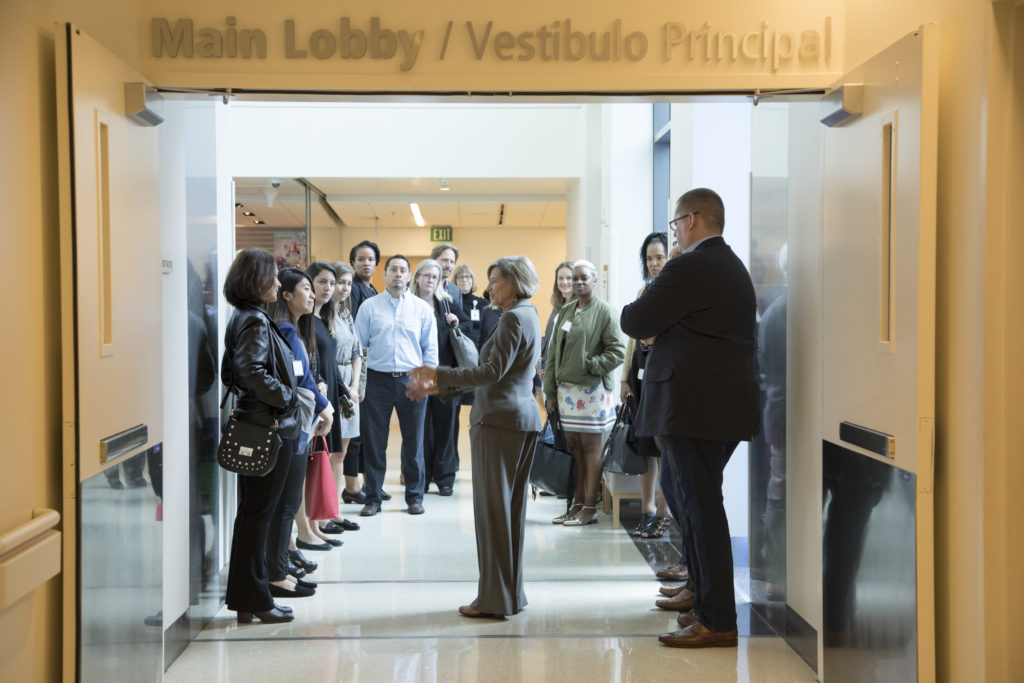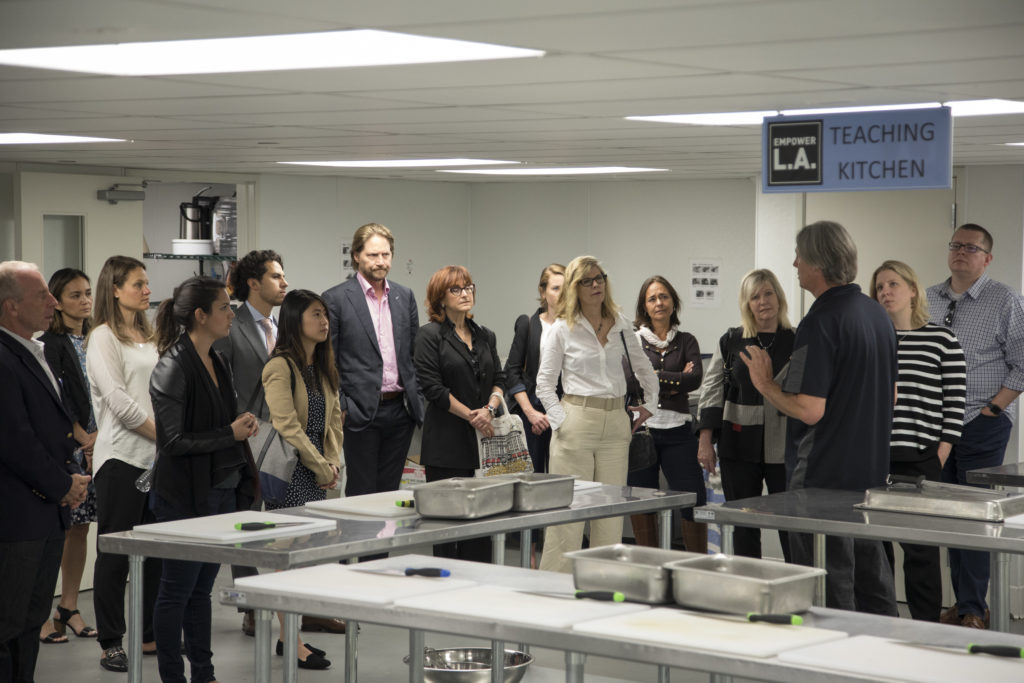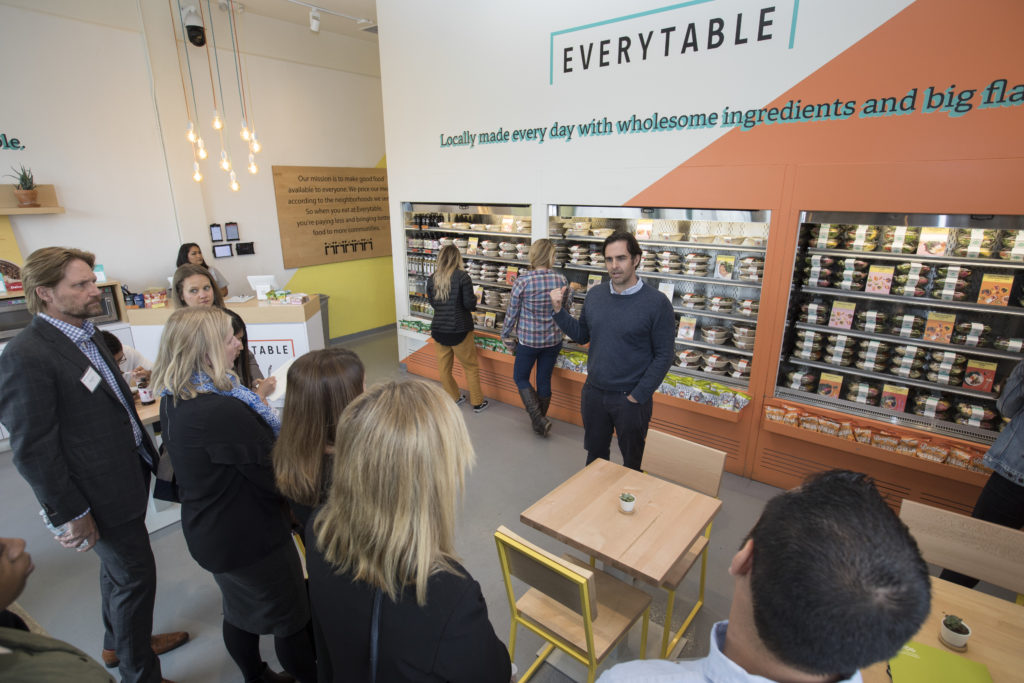The Power of Public-Private Partnerships to Foster Health Through Innovation

How can businesses help create a kinder, healthier world?

May 29, 2018 – Los Angeles, California, USA: The U.S. Chamber of Commerce Foundation Corporate Citizenship Center hosts Fostering Innovation for Healthier Communities, tour and conference. Photo by Ian Wagreich / © U.S. Chamber of Commerce
At the U.S. Chamber of Commerce Foundation — it starts by bringing companies and nonprofits together for a Business Learning Tour in Los Angeles. The convening, spearheaded by Elyse Cohen (senior director for Food, Health, and Wellness programs at the Foundation), and aptly named “Fostering Innovation for Healthier Communities,” elevated the work that many organizations on the ground are doing to innovate and advocate for the most pressing health issues in the nation.
“We’ve been working with the business community to design our social impact programming around several pillars of health — consumer health, workplace health, community health, and environmental health. We’re helping businesses build strategic partnerships and programs and leverage their assets to contribute to societal challenges.” Elyse said. “[It was two days] of visiting sites for on-the-ground visuals and hearing from folks really working on each of these different pillars.”
As Charles Antis, the CEO of Antis Roofing put it, the tour brought together the “caliber of the cohort brands, collaborating to create a more socially responsible world.”
Here are some of the key takeaways:
Health is not just about going to the doctor. Health is about the whole person, physically and mentally – what you eat, how you feel, where you live, what you do in your free time.
Dr. Michael Hochman, a general internist and inaugural director at the USC Gehr Family Center for Health Systems Science, notes that in one of his studies, “One thing we learned is that the medical model of obesity has not been that effective. Patients spend less than 1% of their time in medical clinics, and only about 10% of the factors contributing to premature death are attributed to medical care.”1
Businesses who spend more time with people have the power to influence health trajectories much more profoundly than traditional medical practice does. What affects health more deeply is a combination of behavioral or lifestyle patterns, environmental exposure, and social circumstances, or what we call the social determinants of health. This is evident in the American Health Association’s new Neighborhood Plan to reduce deaths by cardiovascular diseases, which include, alongside healthy food access and decreasing the prevalence of diabetes, transportation, and housing as major priorities.
Partnerships between public and private entities position a unique opportunity for innovation.
County-funded and privately-run, the MLK Community Hospitalis an exemplar of public-private partnership. Walking in is like traversing into the future of healthcare — the floor-to-ceiling windows illuminate a community garden to the left. To the right, a cafeteria that sells only healthy meals (patients can order in anytime they want). Dyan Sublett, President of the MLK Community Hospital Foundation, tells us, “When your patients enter through the doors, you have 60 seconds to prove you care.” And this care is evident in every detail of the hospital, from the private rooms that include sofa-beds for the partners of expecting mothers, to the warm tones in the hallway paintings by local artists such as Cynthia St. Jane.

May 29, 2018 – Los Angeles, California, USA: The U.S. Chamber of Commerce Foundation Corporate Citizenship Center hosts Fostering Innovation for Healthier Communities, tour and conference. Photo by Ian Wagreich / © U.S. Chamber of Commerce
Northgate Gonzalez Marketalso actively represents the intersection of public and private partnerships. A family-owned business that started as a meat and liquor store in 1980, it has expanded to 40 full-service grocery stores in Southern California and taken a deep dive into alleviating obesity and diabetes in the community through both their workers and their customers. Teresa Blanco runs Viva La Salud, a cause-related marketing program in health and wellness for the grocery store chain. She manages an average of 70 monthly events and working with the sales departments to bring in affordable, “healthier-for-you” options.

May 29, 2018 – Los Angeles, California, USA: The U.S. Chamber of Commerce Foundation Corporate Citizenship Center hosts Fostering Innovation for Healthier Communities, tour and conference. Photo by Ian Wagreich / © U.S. Chamber of Commerce
Profit and need do not have to be mutually exclusive.
There are opportunities for companies to incorporate solutions to global challenges, strengthen their communities, and make a profit at the same time. LA Kitchen, the brainchild of Robert Egger, is a prime example. Fourteen-week culinary trainings are offered to people who are formerly incarcerated, homeless, or foster care, who alongside 200 volunteers every week, create healthy meals from reclaimed, imperfect produce. These meals are delivered to low-income senior Angelenos. They also have a for-profit branch, manufacturing healthy products, such as grab-and-go sandwiches at LAX.

May 29, 2018 – Los Angeles, California, USA: The U.S. Chamber of Commerce Foundation Corporate Citizenship Center hosts Fostering Innovation for Healthier Communities, tour and conference. Photo by Ian Wagreich / © U.S. Chamber of Commerce
Another stop on the tour was EveryTable, a fast-food chain founded by Sam Polk and David Foster that offers healthy meals at market price. This means a kale chicken caesar salad for $8 in areas like Santa Monica and $4 in South Los Angeles, or areas known as food deserts — but all meals sold based on profit margin. In fact, EveryTable’s lowest-priced store, with meals sold at an average of $4.75, has become their most profitable, all the while staying affordable and fulfilling the needs of their clientele, which may include a mom on-the-go, with two jobs and three children.

May 29, 2018 – Los Angeles, California, USA: The U.S. Chamber of Commerce Foundation Corporate Citizenship Center hosts Fostering Innovation for Healthier Communities, tour and conference. Photo by Ian Wagreich / © U.S. Chamber of Commerce
In fact, profit is closely tied to a healthier workforce.
Research has continued to demonstrate that chronic disease contributes largely to medical care costs, absenteeism, and lost productivity. A recent study showed that investing a dollar into workplace wellness had a return of $3.27 in medical care costs and $2.23 in absenteeism.2
One way to improve workplace wellness is to improve the workplace itself, where most Americans spend a large percentage of their lives. The tour was hosted at AllSteel showroom in Downtown Los Angeles, which was a recipient of the WELL Building Standard, a testament to how research-based design can have a positive impact on employee wellness.
“It’s more than just furniture,” said Linda Nabulski, AllSteel Regional Sales Manager. “It’s making sure you are building an environment that supports health and supplies things like clean good air, water, a place for relaxation, and more. And building that environment can have a real effect on employees’ well-being.”

May 29, 2018 – Los Angeles, California, USA: The U.S. Chamber of Commerce Foundation Corporate Citizenship Center hosts Fostering Innovation for Healthier Communities, tour and conference. Photo by Ian Wagreich / © U.S. Chamber of Commerce
Another key element of improving employee health is facilitating how mental health is viewed at work. One-fifth of the American population live with mental illnesses, and many go untreated.3
“Almost everyone has a direct connection to mental illness whether it’s themselves, someone they know, or in their community,” said Janaya Nichols, a senior program manager at Well Being Trust.
And yet, stigma is still a huge barrier to people accessing the care they need. According to Time to Change, 95% of employees surveyed said they used a different excuse when calling in sick, even when the concern they had was mental health-related. “Many employees are not comfortable enough to tell their supervisor or colleague that they were struggling,” said Dr. Clayton Chau, Southern California Regional Executive Medical Director of Providence St. Joseph Health System’s Mental Health Network
Dr. Chau suggests that, “One of the biggest things a company can do for mental well-being is to start the process of destigmatizing mental health, and promoting health and well-being as a holistic journey no different from a physical illness.” This may look different for different companies, but could take the form of implementing a “mental health day” specifically geared towards having employees doing something for themselves; starting a company blog sharing personal stories of mental health; including language against discrimination with those with mental illnesses from the HR department; or even something at no cost, asking the company’s Employee Assistance Program (EAP) to come in and provide educational materials to employees on mental health.
It could be something as simple as being kind. Maya Smith, Executive Director of Born This Way Foundation describes a study done in conjunction with the Benenson Strategy Group, “We found that high schools, colleges, and workplaces that defined their communities as kind, were more likely to be mentally healthy. These ‘most kind’ communities identified supervisors who asked them how they were and took the time to ask how they were; teachers who said hello to students by name.”

May 29, 2018 – Los Angeles, California, USA: The U.S. Chamber of Commerce Foundation Corporate Citizenship Center hosts Fostering Innovation for Healthier Communities, tour and conference. Photo by Ian Wagreich / © U.S. Chamber of Commerce
Every business has an opportunity and should have an interest in contributing to health.
We are so often bombarded with grim statistics, such as the 12-year difference in life expectancy between 22 miles (LA counties Watts and Bel-Air4) and the fact that America spends one of the highest amounts in health care, yet we rank bottom in nearly every standard measure of health status.5 Direct and indirect economic costs of mental health were estimated to be $8.5 trillion in 2010 and are expected to double by 2030.6
We live in a time where we can no longer ignore the health disparities that exist throughout our communities, or as keynote speaker Mary Pittman, the President and CEO of Public Health Institute put it, “We are here today because we are sick to death that our communities are sick to death.”
With great challenges comes opportunity to innovate and improve the well-being of communities. Through a blend of site visits, panel discussions, and relationship-building at the Business Learning Tour, we find the potential and power of convening businesses, nonprofits, and government to innovate for a kinder and healthier world.
To read more about the tour and the speakers, please visit: https://www.uschamberfoundation.org/event/business-learning-tour-fostering-innovation-healthier-communities
To learn more about the U.S. Chamber of Commerce Foundation’s Corporate Citizenship Center, please check out their website: https://www.uschamberfoundation.org/corporate-citizenship-center
1Schroeder, S. A. (2007). We Can Do Better — Improving the Health of the American People. New England Journal of Medicine, 357(12), 1221-1228. doi:10.1056/nejmsao73350
2Katherine Baicker, David Cutler and Zirui Song. Workplace Wellness Programs Can Generate Savings
Health Affairs, 29, no.2 (2010):304-311
3Mental Illness. (n.d.). Retrieved from http://www.nimh.nih.gov/health/statistics/prevalence/any-mental-illness-ami-among-adults.shtml
4The Health Atlas. (2015, April 22). Retrieved from http://healthyplan.la/the-health-atlas/
5Papanicolas, I., Woskie, L. R., & Jha, A. K. (2018). Health Care Spending in the United States and Other High-Income Countries. Jama, 319(10), 1024. doi :10.1001/jama.2018.1150
6Trautmann, S., Rehm, J., & Wittchen, H. (2016). The economic costs of mental disorders. EMBO Reports,17(9), 1245-1249. doi :10.15252/embr.201642951
The post The Power of Public-Private Partnerships to Foster Health Through Innovation appeared first on Channel Kindness.
